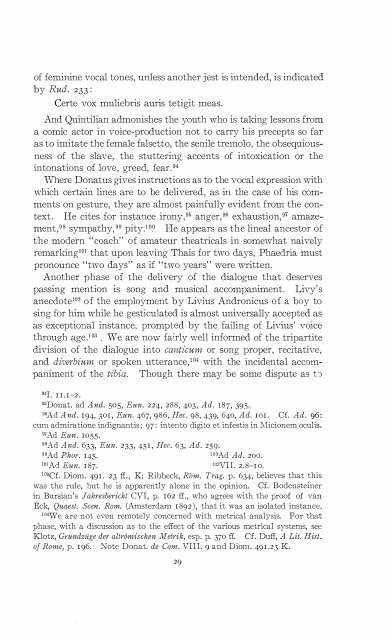You also want an ePaper? Increase the reach of your titles
YUMPU automatically turns print PDFs into web optimized ePapers that Google loves.
of feminine vocal tones, unless another jest is intended, is indicated<br />
by Rud. 233 :<br />
Certe vox muliebris auris tetigit meas.<br />
And Quintilian admonishes the youth who is taking lessons from<br />
a comic actor in voice-production not to carry his precepts so far<br />
as to imitate the female falsetto, the senile tremolo, the obsequiousness<br />
of the slave, the stuttering accents of intoxication or the<br />
intonations of love, greed, fear.94<br />
<strong>IN</strong>here Donatus gives instructions as to the vocal expression with<br />
which certain lines are to be delivered, as in the case of his comments<br />
on gesture, they are almost painfully evident from the context.<br />
He cites for instance irony,95 anger,96 exhaustion,97 amaze-·<br />
ment,98 sympathy,99 pity.loO He appears as the lineal ancestor of<br />
the modern "coach" of amateur theatricals in somewhat naively<br />
remarking101 that upon leaving Thais for two days, Phaedria must<br />
pronounce "two days" as if "two years" were written.<br />
Another phase of the delivery of the dialogue that deserves<br />
passing mention is song and musical accompaniment. Livy's<br />
anecdote102 of the employment by Livius Andronicus of a boy to<br />
sing for him while he gesticulated is almost universally accepted as<br />
as exceptional instance, prompted by the failing of Livius' voice<br />
through age.I03 We are now fairly well informed of the tripartite<br />
division of the dialogue into canticum or song proper, recitative,<br />
and diverbium or spoken utterance,I04 with the incidental accompaniment<br />
of the tibia. Though there may be some dispute as tJ<br />
941. 11.1-2 .<br />
95Donat. ad And. 505, Eun. 224, 288, 403, Ad. 187, 395.<br />
"A d And. 194, 301, Eun. 467, 986, Hee. 98, 439, 640, Ad. IOI. Cf. Ad. 96:<br />
cum admiratione indignantis ; 97 : intento digito et infestis in Micionem oculis.<br />
97Ad Eun. 1055.<br />
9sAd And. 633, Eun. 233, 451, Hee. 63, Ad. 259.<br />
'9Ad Pharo 145.<br />
looAd Ad. 200.<br />
IOIAd Eun. 187. I02VII. 2.8-1 0.<br />
]03Cf. Diom. 49 1. 23 ff., K; Ribbeck, Rom. Trag. p. 634, believes that this<br />
was the rule, but he is apparently alone in the opinion. Cf. Bodensteiner<br />
in Bursian's Jahresberieht CVI, p. 162 ff., who agrees with the proof of van<br />
Eck, Quaest. Seen. Rom. (Amsterdam 1892), that it was an isolated instance.<br />
IO' We are not even remotely concerned with metrical analysis. For that<br />
phase, with a discussion as to the effect of the various metrical systems, see<br />
Klotz, Grundzuge der altromisehen Metrik, esp. p. 370 ff. Cf. Duff, A Lit. Hist.<br />
of Rome, p. 196. Note Donat. de Com. VIII. 9 and Dioffi. 49 1.23 K.<br />
29
















